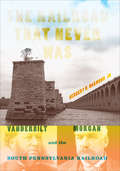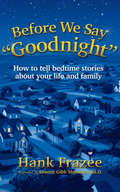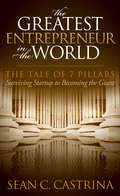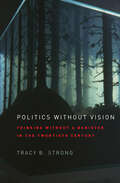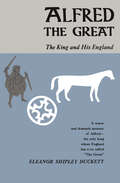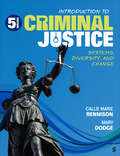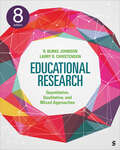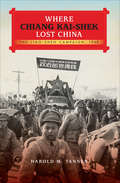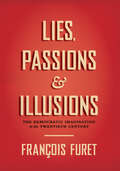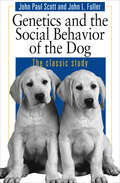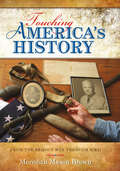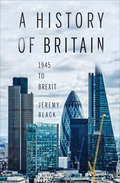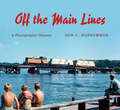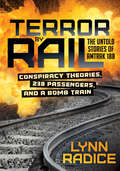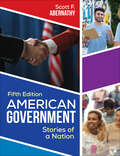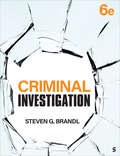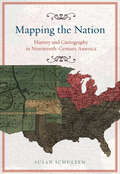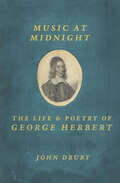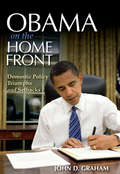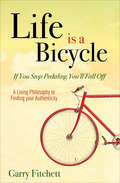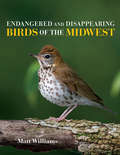- Table View
- List View
The Railroad That Never Was: Vanderbilt, Morgan, and the South Pennsylvania Railroad (Railroads Past and Present)
by Herbert H. Harwood Jr.This account of a doomed enterprise is &“an important contribution to both rail and road history, as well as to business history&”—photos and maps included (The Lexington Quarterly). Stretching over two hundred miles through Pennsylvania&’s most challenging mountain terrain, the South Pennsylvania Railroad would form the heart of a new trunk line, from the East Coast to Pittsburgh and the Midwest. Conceived in 1881 by William H. Vanderbilt, Andrew Carnegie, and a group of Pittsburgh and Philadelphia industrialists, it was intended to break the rival Pennsylvania Railroad&’s near-monopoly in the region. But the line was within a year of opening when J.P. Morgan brokered a peace treaty that aborted the project and helped bolster his position in the world of finance. The railroad right of way and its tunnels would sit idle for sixty years—before coming to life in the late 1930s as the original section of the Pennsylvania Turnpike. Based on original letters, documents, diaries, and newspaper reports, The Railroad That Never Was uncovers the truth behind this mysterious railway, one of the most infamous construction projects of the late nineteenth century.
Before We Say "Goodnight": How to Tell Bedtime Stories About Your Life and Family
by Hank FrazeeA unique way to turn bedtime stories into an opportunity to strengthen our bond with our children. Before We Say &“Goodnight&” will show you how to captivate your child&’s imagination with a subject they literally can&’t get enough of—you. In this book, you&’ll discover an easy-to-learn three-step method to turn your life experiences, and those of your family, into great bedtime stories, all without notes or memorization. Best of all, you&’ll make bedtime one of the happiest parts of the day. &“Our children and grandchildren want to know who we really are. This book provides a wonderful method to share our life with those we love. It&’s out of this world!&” —Buzz Aldrin, astronaut
The Greatest Entrepreneur in the World: The Tale of 7 Pillars: Surviving Startup to Becoming the Giant
by Sean C. CastrinaA dramatic tale distilling the seven irrefutable truths required for starting, surviving and growing a profitable business or thriving organization. Johnny Dawkins cofounded a small media company that became a Wall Street giant. But now he must make &“the decision&” that will dictate the fate of everything he has worked so hard to achieve. With everything riding on his choice, Johnny draws from a lifetime of experiences with his partner and mentor—The Greatest Entrepreneur in the World—to reach his much-anticipated pronouncement . . . With this inspiring fable, Sean C. Castrina shares and expounds on the Seven Pillars—the foundations required to fortify a successful startup business, division or organization. Wrapped in a gripping tale of high stakes business, the tools revealed within will help the entrepreneurs of today and tomorrow build their empires and disrupt the status quo. You won&’t be able to put down this gripping story that teaches essential lessons for the aspiring entrepreneur and organizational trailblazer.
Politics without Vision: Thinking without a Banister in the Twentieth Century
by Tracy B. Strong&“Magisterial…a frequently surprising treatment of major political thinkers.&”—Perspectives on Politics From Plato through the nineteenth century, the West could draw on comprehensive political visions to guide government and society. Now, for the first time in more than two thousand years, Tracy B. Strong contends, we have lost our foundational supports. In the words of Hannah Arendt, the state of political thought in the twentieth and twenty-first centuries has left us effectively thinking without a banister. Politics without Vision takes up the thought of seven influential thinkers, each of whom attempted to construct a political solution to this problem: Nietzsche, Weber, Freud, Lenin, Schmitt, Heidegger, and Arendt. None of these theorists were liberals; nor, excepting possibly Arendt, were they democrats—and some might even be said to have served as handmaidens to totalitarianism. And all, to a greater or lesser extent, shared the common conviction that the institutions and practices of liberalism are inadequate to the demands and stresses of the present times. In examining their thought, Strong acknowledges the political evil that some of their ideas served to foster but argues that these were not necessarily the only paths their explorations could have taken. By uncovering the turning points in their thought—and the paths not taken—Strong strives to develop a political theory that can avoid, and perhaps help explain, the mistakes of the past while furthering the democratic impulse. Confronting the widespread belief that political thought is on the decline, Strong puts forth a brilliant and provocative counterargument that in fact it has endured—without the benefit of outside support. A compelling rendering of contemporary political theory, Politics without Vision is sure to provoke discussion among scholars in many fields.
Alfred the Great: The King and His England (Phoenix Books)
by Eleanor Shipley DuckettFrom the author of The Gateway to the Middle Ages, &“a fascinating portrait of an enlightened monarch against a background of darkness and ignorance&” (Kirkus Reviews). Filled with drama and action, here is the story of the ninth-century life and times of Alfred—warrior, conqueror, lawmaker, scholar, and the only king whom England has ever called &“The Great.&” Based on up-to-date information on ninth-century history, geography, philosophy, literature, and social life, it vividly presents exciting views of Alfred in every stage of his long career and leaves the reader with a sharply etched picture of the world of the Middle Ages.
Introduction to Criminal Justice: Systems, Diversity, and Change
by Callie Marie Rennison Mary J. DodgeIntroduction to Criminal Justice: Systems, Diversity, and Change, Fifth Edition offers students a brief, yet thorough, introduction to criminal justice with up-to-date coverage of all aspects of the system in succinct and engaging chapters. Authors Callie Marie Rennison and Mary Dodge weave four true criminal case studies throughout the book, capturing students’ attention with memorable stories that illustrate the real-life pathways and outcomes of criminal behavior and victimization. These case studies provide a fresh, exciting, and practical view of the interconnected criminal justice system. The text also explores often-overlooked topics such as victims, terrorism, white-collar crime, diversity, and the role of the media, providing a more complete understanding of the system’s complexities.
Educational Research: Quantitative, Qualitative, and Mixed Approaches
by Robert Burke Johnson Larry B. ChristensenEducational Research: Quantitative, Qualitative, and Mixed Approaches by R. Burke Johnson and Larry Christensen offers a comprehensive, accessible introduction to research methods for undergraduate and graduate students. Readers will develop an understanding of the multiple research methods and strategies used in education and related fields, including how to read and critically evaluate published research and how to write a proposal, construct a questionnaire, and conduct an empirical research study on their own. The Eighth Edition maintains the features that made this book a best-seller, including attention-grabbing chapter-opening vignettes, lively examples that engage student interest, a conversational and friendly writing style, and more. Fully updated for the Seventh Edition of the Publication Manual of the American Psychological Association, this new edition includes expanded information on research ethics and IRBs, expanded and more current information on sampling and causation across research designs, and the latest thinking on mixed methods research. Designed to make learning about research methods enjoyable without sacrificing the necessary rigor, this highly readable text transforms readers into critical consumers and users of research.
Introduction to Criminal Justice: Systems, Diversity, and Change
by Callie Marie Rennison Mary J. DodgeIntroduction to Criminal Justice: Systems, Diversity, and Change, Fifth Edition offers students a brief, yet thorough, introduction to criminal justice with up-to-date coverage of all aspects of the system in succinct and engaging chapters. Authors Callie Marie Rennison and Mary Dodge weave four true criminal case studies throughout the book, capturing students’ attention with memorable stories that illustrate the real-life pathways and outcomes of criminal behavior and victimization. These case studies provide a fresh, exciting, and practical view of the interconnected criminal justice system. The text also explores often-overlooked topics such as victims, terrorism, white-collar crime, diversity, and the role of the media, providing a more complete understanding of the system’s complexities.
Where Chiang Kai-shek Lost China: The Liao-Shen Campaign, 1948 (Twentieth-Century Battles)
by Harold M. Tanner&“A masterful contribution not simply to the history of the civil war, but also to the history of 20th century China.&” —Steven I. Levine author, Anvil of Victory: The Communist Revolution in Manchuria, 1945-1948) The civil war in China that ended in the 1949 victory of Mao Zedong&’s Communist forces was a major blow to U.S. interests in the Far East and led to heated recriminations about how China was &“lost.&” Despite their significance, there have been few studies in English of the war&’s major campaigns. The Liao-Shen Campaign was the final act in the struggle for control of China&’s northeast. After the Soviet defeat of Japan in Manchuria, Communist Chinese and then Nationalist troops moved into this strategically important area. China&’s largest industrial base and a major source of coal, Manchuria had extensive railways and key ports (both still under Soviet control). When American mediation over control of Manchuria failed, full-scale civil war broke out. By spring of 1946, Chiang Kai-shek&’s Nationalist armies had occupied most of the southern, economically developed part of Manchuria, pushing Communist forces north of the Songhua (Sungari) River. But over the next two years, the tide would turn. The Communists isolated the Nationalist armies and mounted a major campaign aimed at destroying the Kuomintang forces. This is the story of that campaign and its outcome, which were to have such far-reaching consequences. &“Where Chiang Kai-shek Lost China is more than a fluidly written battle narrative or operational history. By tapping an impressive array of archival materials, published document collections, and memoirs, Harold Tanner has put the Liao-Shen Campaign in the larger context of the Chinese Civil War and significantly advanced our understanding of the military history of modern China.&” —Michigan War Studies Review
Lies, Passions & Illusions: The Democratic Imagination in the Twentieth Century
by François FuretA critical history of 20th century political movement by the Hannah Arendt Prize-winning author of Interpreting the French Revolution. Widely considered one of the leading historians of the French Revolution, François Furet was hailed as &“one of the most influential men in contemporary France&” by the New York Review of Books. In Lies, Passions, and Illusions, Furet&’s presents a cohesive, late-career meditation on the political passions of the twentieth century, drawn from a wide-ranging conversation between Furet and philosopher Paul Ricoeur. Published posthumously, it is Furet&’s final statement on history and politics. With strokes at once broad and incisive, Furet examines the many different trajectories that nations of the West have followed over the past hundred years. It is a dialogue with history as it happened but also as a form of thought. It is a dialogue with his critics, with himself, and with those major thinkers—from Tocqueville to Hannah Arendt—whose ideas have shaped our understanding of the tragic dramas and upheavals of the modern era. It is a testament to the crucial role of the historian, a reflection on how history is made and lived, and how the imagination is a catalyst for political change.
Genetics and the Social Behavior of the Dog
by John Paul Scott John L. FullerThe classic study of canine behavior: &“A major authoritative work…Immensely rewarding reading for anyone concerned with dog-breeding.&”—Times Literary Supplement Based on twenty years of research at the Jackson Laboratory, this is the single most important and comprehensive reference work on the behavior of dogs ever compiled, written by geneticist and comparative psychologist John Paul Scott, known for his research into social behavior and aggression. &“One of the most important texts on canine behavior published to date. Anyone interested in breeding, training, or canine behavior must own this book.&”—Wayne Hunthausen, D.V.M., Director of Animal Behavior Consultations &“This pioneering research on dog behavioral genetics is a timeless classic for all serious students of ethology and canine behavior.&”—Dr. Michael Fox, Senior Advisor to the President, The Humane Society of the United States &“Comprehensive…[a] seminal work.&”—Mark Derr, The Atlantic Monthly &“Essential reading for anyone involved in the breeding of dogs. No breeder can afford to ignore the principles of proper socialization first discovered and articulated in this landmark study.&”—The Monks of New Skete, authors of How to Be Your Dog's Best Friend and the video series Raising Your Dog with the Monks of New Skete
Touching America's History: From the Pequot War Through WWII (Encounters: Explorations in Folklore and Ethnomusicology)
by Meredith Mason BrownObjects that make the past feel real, from a stone axe head to a piece of John Brown&’s scaffold—includes photos. History isn&’t just about abstract &“isms&”—it&’s the story of real events that happened to real people. In Touching America&’s History, Meredith Mason Brown uses a collection of such objects, drawing from his own family&’s heirlooms, to summon up major developments in America&’s history. The objects range in date from a Pequot stone axe head, probably made before the Pequot War in 1637, to the western novel Dwight Eisenhower was reading while waiting for the weather to clear so the Normandy Invasion could begin, to a piece of a toilet bowl found in the bombed-out wreckage of Hitler&’s home in 1945. Among the other historically evocative items are a Kentucky rifle carried by Col. John Floyd, killed by Indians in 1783; a letter from George Washington explaining why he will not be able to attend the Constitutional Convention; shavings from the scaffold on which John Brown was hanged; a pistol belonging to Gen. William Preston, in whose arms Gen. Albert Sidney Johnston bled to death after being shot at the Battle of Shiloh; and the records of a court-martial for the killing by an American officer of a Filipino captive during the Philippine War. Together, these objects call to mind nothing less than the birth, growth, and shaping of what is now America. &“Clearly written, buttressed by maps and portraits, Brown's book regales while showing the objectivity and nuance of a historian.&”—Library Journal &“A whole new way of doing history…a novel form of story-telling.&”—Joseph J. Ellis, Pulitzer Prize-winning author of Founding Brothers: The Revolutionary Generation
A History of Britain: 1945 to Brexit
by Jeremy BlackA journey through the events of the postwar years that &“makes the outcome of Britain&’s Brexit referendum much easier to comprehend&” (Julian Lewis, member of Parliament). In 2016, Britain stunned itself and the world by voting to pull out of the European Union, leaving financial markets reeling and global politicians and citizens in shock. But was Brexit really a surprise, or are there clues in Britain&’s history that pointed to this moment? In A History of Britain: 1945 to Brexit, award-winning historian Jeremy Black reexamines modern British history, considering the social changes, economic strains, and cultural and political upheavals that brought Britain to Brexit. This sweeping and engaging book traces Britain&’s path through the destruction left behind by World War II, Thatcherism, the threats of the IRA, the Scottish referendum, and on to the impact of waves of immigrants from the European Union. Along the way, Black overturns many conventional interpretations of significant historical events, provides context for current developments, and encourages the reader to question why we think the way we do about Britain&’s past.
Off the Main Lines: A Photographic Odyssey (Railroads Past and Present)
by Don L. HofsommerA railway history expert &“vividly portrays a way of life no longer seen. A fascinating insight into historical American railroading&” (Railways Illustrated). In this visually stunning and comprehensive photographic essay, railroad historian and photographer Donovan L. Hofsommer records the end of branchline passenger service, the demise of electric railroads, the transition from steam to diesel power, as well as the end of common carrier freight service on the Colorado narrow gauge. Off the MainLines carries readers along out-of-the-way railways in Iowa, Minnesota, Missouri, Colorado, Oklahoma, Texas, Montana, and South Dakota to see the changes that occurred on these lines from the 1940s to the 1990s. &“If you miss the Milwaukee, recall the Rock Island, suffer from the loss of the Soo Line, maintain sadness for the Santa Fe, can&’t forget the Frisco, absent-mindedly buried the Burlington Route in oblivion or still maintain romantic recollections of the Katy, you&’ll find Dr. Hofsommer&’s Off the Main Lines exactly where you need to be!&”—Lexington Quarterly &“A fitting tribute to its subject; railroad enthusiasts across the upper Midwest and beyond will find Hofsommer&’s personalized history to be both edifying and immensely rewarding.&”—The Annals of Iowa &“An interesting blend of historical fact and personal reminiscence, and traces the author&’s own personal 60-year rail odyssey to a variety of &‘off the beaten path&’ locations.&”—Michigan Railfan &“All in all this is a good photographic essay of some lesser known routes and, as usual, I picked up a few more pieces of information to use at a railroad trivia night.&”—The Villager
Terror by Rail: Conspiracy Theories, 238 Passengers, and a Bomb Train: The Untold Stories of Amtrak 188
by Lynn RadiceA survivor&’s true story of a railway catastrophe that transformed her life—and turned her into a passionate advocate for safety and disaster prevention. Terror by Rail is the compelling true story of a major catastrophic event: the Amtrak 188 accident on May 12, 2015. After the accident, Lynn Radice faced a difficult journey of recovery from trauma—and at the same time, her passion for answers caused her to ask questions about train safety and the bigger global issues that are challenges of the rail. A must read for anyone who travels, lives, or works near a rail system, Terror by Rail is a wakeup call. As the phrase goes, &“See Something Say Something&”—and in this book, the author is doing just that. This story of a single mom&’s heartbreaking journey through hell and back will give everyone facing challenges in their life a bit of hope that nothing is permanent, and it is possible to come through the pain to the other side, and make things better in the process.
American Government: Stories of a Nation
by Scott F. AbernathyAmerican government is not just one story—it’s many stories. Our stories. And they are still being told. In American Government: Stories of a Nation, Scott F. Abernathy tunes into the diverse perspectives and political persuasions involved in American politics. This balanced approach encourages students to actively engage with the material while facilitating a thoughtful exploration of important themes in politics, governance, and current events. Known for addressing issues in a way that is both relatable and solidly grounded in research, the Fifth Edition delivers new ways for students to understand and participate in politics.
Educational Research: Quantitative, Qualitative, and Mixed Approaches
by Robert Burke Johnson Larry B. ChristensenEducational Research: Quantitative, Qualitative, and Mixed Approaches by R. Burke Johnson and Larry Christensen offers a comprehensive, accessible introduction to research methods for undergraduate and graduate students. Readers will develop an understanding of the multiple research methods and strategies used in education and related fields, including how to read and critically evaluate published research and how to write a proposal, construct a questionnaire, and conduct an empirical research study on their own. The Eighth Edition maintains the features that made this book a best-seller, including attention-grabbing chapter-opening vignettes, lively examples that engage student interest, a conversational and friendly writing style, and more. Fully updated for the Seventh Edition of the Publication Manual of the American Psychological Association, this new edition includes expanded information on research ethics and IRBs, expanded and more current information on sampling and causation across research designs, and the latest thinking on mixed methods research. Designed to make learning about research methods enjoyable without sacrificing the necessary rigor, this highly readable text transforms readers into critical consumers and users of research.
Criminal Investigation
by Steven G. BrandlCriminal Investigation, Sixth Edition offers a comprehensive and engaging examination of criminal investigation and the vital role criminal evidence plays in the process. Written in a straightforward manner, the text focuses on the five critical areas essential to understanding criminal investigations: background and contextual issues, criminal evidence, legal procedures, evidence collection procedures, and forensic science. In this brand new edition, author Steven G. Brandl goes beyond a simple how-to on investigative procedures, and draws from fascinating modern research, comprehensive cases, and criminal evidence to demonstrate their importance in the real world of criminal justice, providing students with practical insights into the field of criminal investigation.
American Government: Stories of a Nation
by Scott F. AbernathyAmerican government is not just one story—it’s many stories. Our stories. And they are still being told. In American Government: Stories of a Nation, Scott F. Abernathy tunes into the diverse perspectives and political persuasions involved in American politics. This balanced approach encourages students to actively engage with the material while facilitating a thoughtful exploration of important themes in politics, governance, and current events. Known for addressing issues in a way that is both relatable and solidly grounded in research, the Fifth Edition delivers new ways for students to understand and participate in politics.
Criminal Investigation
by Steven G. BrandlCriminal Investigation, Sixth Edition offers a comprehensive and engaging examination of criminal investigation and the vital role criminal evidence plays in the process. Written in a straightforward manner, the text focuses on the five critical areas essential to understanding criminal investigations: background and contextual issues, criminal evidence, legal procedures, evidence collection procedures, and forensic science. In this brand new edition, author Steven G. Brandl goes beyond a simple how-to on investigative procedures, and draws from fascinating modern research, comprehensive cases, and criminal evidence to demonstrate their importance in the real world of criminal justice, providing students with practical insights into the field of criminal investigation.
Mapping the Nation: History and Cartography in Nineteenth-Century America
by Susan Schulten&“A compelling read&” that reveals how maps became informational tools charting everything from epidemics to slavery (Journal of American History). In the nineteenth century, Americans began to use maps in radically new ways. For the first time, medical men mapped diseases to understand and prevent epidemics, natural scientists mapped climate and rainfall to uncover weather patterns, educators mapped the past to foster national loyalty among students, and Northerners mapped slavery to assess the power of the South. After the Civil War, federal agencies embraced statistical and thematic mapping in order to profile the ethnic, racial, economic, moral, and physical attributes of a reunified nation. By the end of the century, Congress had authorized a national archive of maps, an explicit recognition that old maps were not relics to be discarded but unique records of the nation&’s past. All of these experiments involved the realization that maps were not just illustrations of data, but visual tools that were uniquely equipped to convey complex ideas and information. In Mapping the Nation, Susan Schulten charts how maps of epidemic disease, slavery, census statistics, the environment, and the past demonstrated the analytical potential of cartography, and in the process transformed the very meaning of a map. Today, statistical and thematic maps are so ubiquitous that we take for granted that data will be arranged cartographically. Whether for urban planning, public health, marketing, or political strategy, maps have become everyday tools of social organization, governance, and economics. The world we inhabit—saturated with maps and graphic information—grew out of this sea change in spatial thought and representation in the nineteenth century, when Americans learned to see themselves and their nation in new dimensions.
Music at Midnight: The Life and Poetry of George Herbert
by John DruryThis &“powerfully absorbing&” biography of 17th century Welsh poet George Herbert brings essential personal and social context to his immortal poetry (Financial Times). Though he never published any of his English poems during his lifetime, George Herbert has been celebrated for centuries as one of the greatest religious poets in the language. In this richly perceptive biography, author and theologian John Drury integrates Herbert&’s poems fully into his life, enriching our understanding of both the poet&’s mind and his work. As Drury writes in his preface, Herbert lived &“a quiet life with a crisis in the middle of it.&” Beginning with his early academic success, Drury chronicles the life of a man who abandons the path to a career at court and chooses to devote himself to the restoration of a church in Huntingdonshire and lives out his life as a country parson. Because Herbert&’s work was only published posthumously, it has always been difficult to know when or in what context he wrote his poems. But Drury skillfully places readings of the poems into his narrative, allowing us to appreciate not only Herbert&’s frame of mind while writing, but also the society that produced it. He reveals the occasions of sorrow, happiness, regret, and hope that Herbert captured in his poetry and that led T. S. Eliot to write, &“What we can confidently believe is that every poem . . . is true to the poet&’s experience.&” &“It is hard to imagine a better book for anyone, general reader or seventeenth-century aficionado or teacher or student, newly embarking on Herbert.&”—The Guardian, UK
Obama on the Home Front: Domestic Policy Triumphs and Setbacks (Encounters: Explorations in Folklore and Ethnomusicology)
by John D. Graham&“The best comprehensive review of the Obama administration&’s policies available,&” by the author of Bush on the Home Front (Daniel P. Franklin, author of Pitiful Giants: Presidents in their Final Term). Barack Obama came into office as the economy was careening into the worst downturn since the Great Depression. On the political front, he would be challenged by the same intense congressional polarization faced by Bill Clinton and George W. Bush, now exacerbated by the rise of the Tea Party movement. In this comprehensive assessment of domestic policymaking, John D. Graham considers what we may learn from the Obama presidency about how presidents can best implement their agendas when Congress is evenly divided. What did Obama pledge to do in domestic policy and what did he actually accomplish? Why did some initiatives succeed and others fail? Did Obama&’s policies contribute to the losses experienced by the Democratic Party in 2010 and 2014? In carefully documented case studies of economic policy, health care reform, energy and environmental policy, and immigration reform, Graham asks whether Obama was effective at accomplishing his agenda. Counterfactuals are analyzed to suggest ways that Obama might have been even more effective than he was and at less political cost to his party. As with the author&’s acclaimed Bush on the Home Front, this book elaborates and applies a theory of presidential effectiveness in a polarized political environment.
Life is a Bicycle: A Living Philosophy to Finding your Authenticity
by Garry FitchettA new philosophy for finding joy and fulfillment through work, and identifying the career path that&’s right for you. Historically, men and women have worked to provide the bare essentials for everyday life. Life is a Bicycle examines work&’s higher purpose: to nurture the advancing mind and unfold the soul. It is your birthright to express yourself harmoniously through your daily work. Using the bicycle as a metaphor for the journey, this book lets you discover: The largest collection of quotes ever assembled capturing the art of discovering sincere, heartfelt workFour fountainheads that reveal and spur your desire, will, and lovePrinciples that will guide you through an evolution of thought en route to your professional bestEnlightening exercises and insightful questions designed to reveal your true natureThe mechanics—but more importantly the heart and soul—of how to discover your professional authenticity If you believe your talent, energy, and appetite indicate ideal work that is capable of bringing out your best while reaping the greatest professional enjoyment possible—and this is the life you want—then you must answer the question: Who&’s riding my bicycle?
Endangered and Disappearing Birds of the Midwest
by Matt WilliamsThis bird-lover&’s guide to spotting the endangered birds of the Midwest features fascinating information, helpful maps, and stunning color photography.Birds captivate us with their lively behavior and colorful beauty. They also enhance our environments in many ways, from controlling pest populations to pollinating crops. Yet, sadly, many species of birds across Minnesota, Wisconsin, Illinois, Iowa, Indiana, Michigan, and Ohio are in danger of extinction due to loss of habitat, agricultural expansion, changing forest conditions, and encounters with humans.In Endangered and Disappearing Birds of the Midwest, conservationist and endangered species expert Matt Williams profiles forty of the most beautiful and fascinating birds who winter, breed, or migrate through the Midwest and whose populations are most in danger of disappearing from the region. Each profile includes the current endangered status of the species, a description of the bird's vocal and nesting patterns, and tips to help readers identify them, along with stunning color images and detailed migration maps. An exquisite and timely examination of our feathered friends, Endangered and Disappearing Birds of the Midwest is a call to action to protect these vulnerable and gorgeous creatures that enliven our world.
